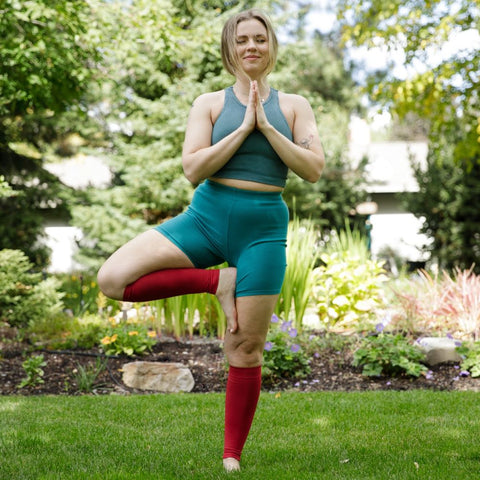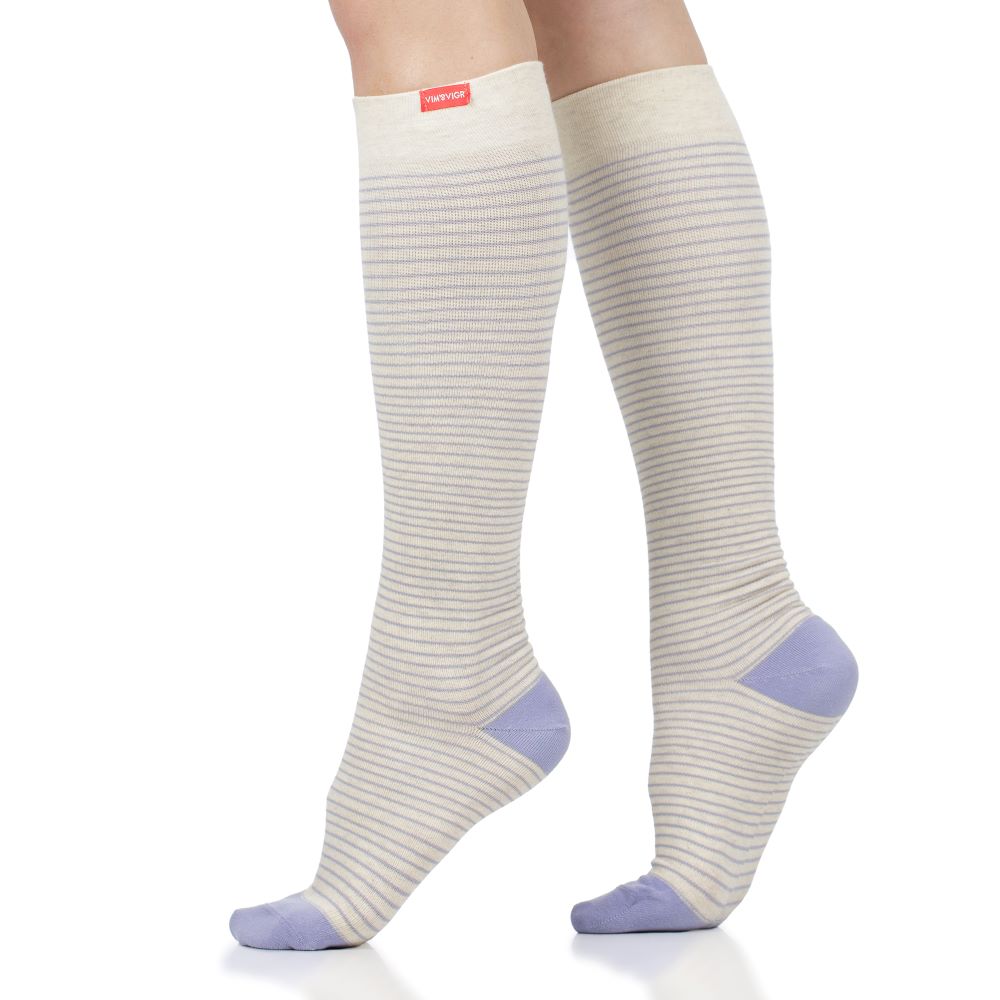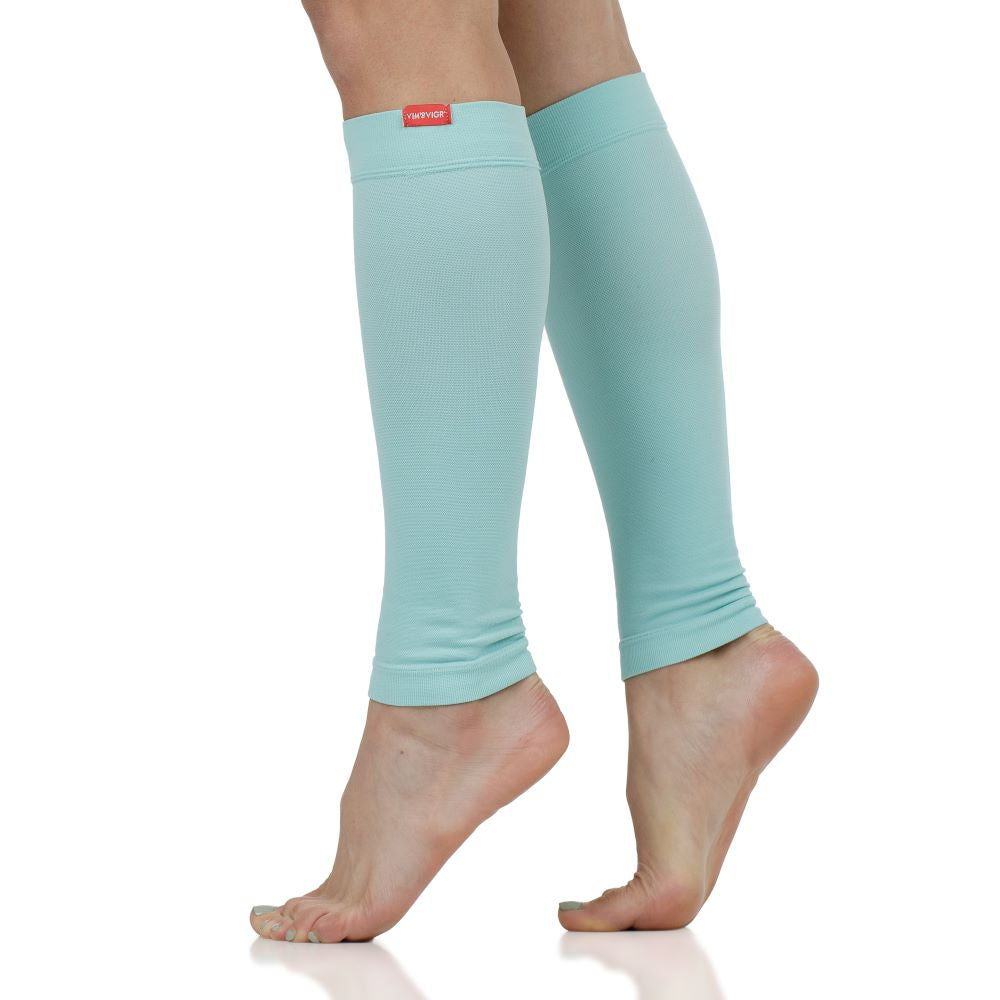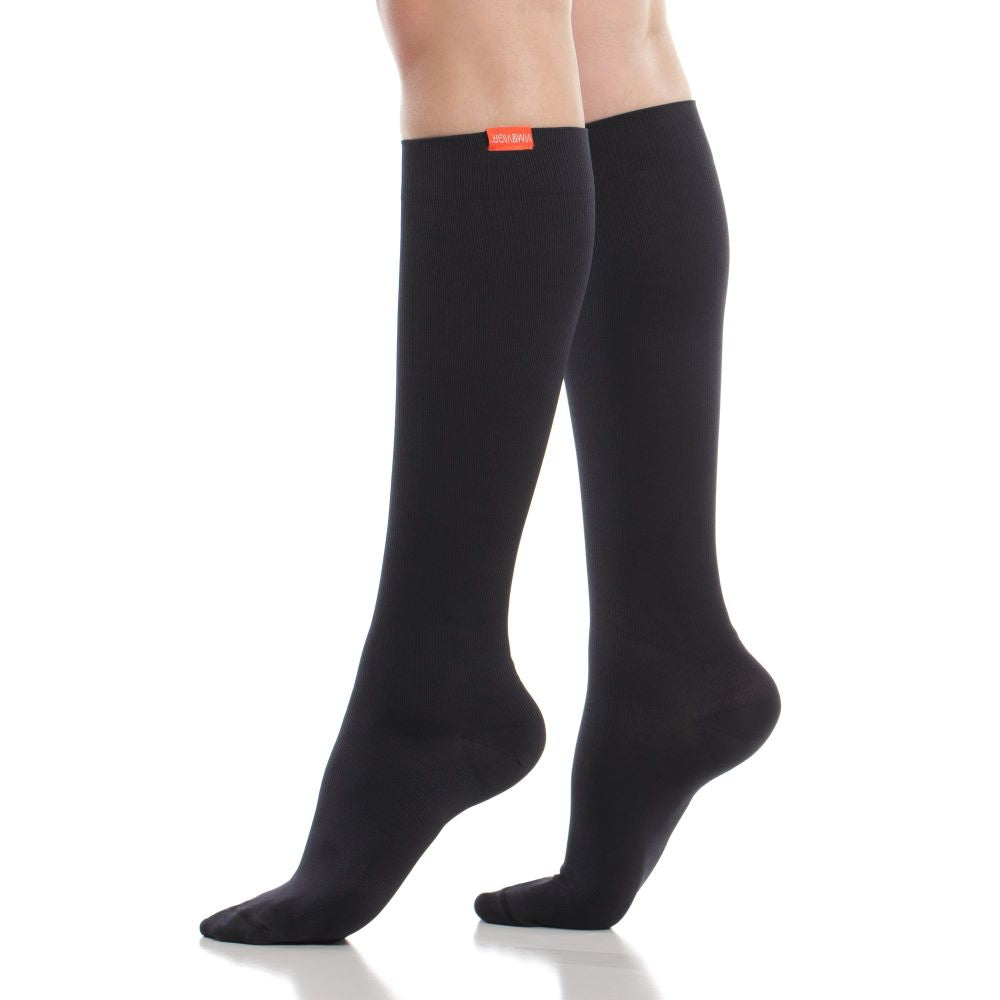What are Compression Yoga Socks & Should You Wear Them?
Written By Alecsa Stewart
Practicing yoga is a grounding, excellent form of exercise for almost any age and physical fitness level. But what are the most comfortable garments to wear for your workout? As you look for some relaxed, yet comfortable, and still tight enough clothing to accompany you in each pose, compression socks can be a perfect accessory.
What are compression yoga socks and why should you wear them for your practice? Boosting blood flow to the lower legs and keeping your joints tight and secure, compression socks support your muscles, improve performance, and help you recover in between sessions.
Read on to find out all you need to know about compression yoga socks, their benefits, the best types, and how to find the right pair for you.
What are Compression Yoga Socks?
Compression socks are tight-fitting socks made of material that enhances circulation in the lower limbs, delivering multiple benefits when worn. The graduated compression applied to the lower legs means that blood flow is stimulated back towards the heart while you exercise, all while giving your muscles a gentle squeeze.
Wearing compression socks for yoga helps you feel more secure and supported in the ankle area, which is ideal if you’re recovering from an injury or are new to the practice. Compression fights the onset of swelling, aches, and pains, too.

Is It Ok to Wear Compression Socks for Yoga?
Ultimately, wearing socks on the yoga mat is a matter of preference. Some people would rather not have anything on their feet when practicing, while others wear grippy socks to help anchor them when they’re doing more difficult poses. However, compression socks can feel really good during yoga practice, as well as after your workout.
There are similarities between the benefits you get from yoga and the ones you get from wearing compression socks, actually. Both increase your circulatory health, allowing blood to move freely throughout your body and keep you healthy and strong. Through the stretches and poses you practice during yoga, you improve your flexibility, but also reduce the likelihood of having swollen ankles and legs. When you wear compression socks, you’re also fighting against blood pooling in the lower legs and leading to edema or varicose veins. As you can see, compression socks and yoga go hand in hand really well!
How Compression Socks Work With Yoga
So, what can you expect from wearing compression socks when you hit the yoga mat? There are two ways in which you can notice their impact: the effects of boosted blood flow and the feeling of joint and muscle stability.
When you practice yoga, especially as a beginner, you may find yourself in poses that lead to the feet and legs going numb or tingling. This is absolutely normal, as you’re challenging your body to work in ways that it is unfamiliar with. Maintaining certain yoga poses (especially when doing yin yoga, where stretches are held for long periods of time) can inhibit peripheral blood circulation. Wearing compression socks helps stimulate the blood flow around ankles and lower legs. This can help reduce your risk of getting those “pins and needles,” avoiding aches and pains that come with bad circulation.
Moreover, compression socks and stockings fit tight on the lower leg muscles, giving additional support and stability during exercise. Graduated compression socks are tightest at the ankle, getting looser towards the knees. This makes them feel really supportive for the joints and calf muscles. If you’re less flexible (especially in the Achilles tendon) or are recovering from an injury, that added security will make you feel more confident and stable during your session.

The Benefits of Compression Socks for Yoga
Why wear compression socks when you practice yoga? Whether you’re an avid gym goer, an occasional dabbler at home, or have joined a yoga studio, the benefits they bring for your circulation and muscles can all help you have a better, more enjoyable experience.
Improving Performance
A systematic review of studies on the effects of compression socks on athletic performance found that, for some people, the boost in blood flow and the general stability and support offered by compression socks improved their performance in sports. This may not be the first thing you consider when you take up yoga, however.
Generally, yoga sessions focus on getting you grounded and relaxed. They’re not so much about athletic performance in the traditional sense. For the regular yoga studio goer, the goal is to work on balance, stability, and flexibility, while unwinding and meditating. Some find a spiritual connection, others attend for physical benefits only.
So, what’s the role of compression socks in improving performance on the mat? They allow you to enjoy your sessions without worrying about possible cramps, numb toes, or tingling feet. They also work with your body to support your movements, as they maintain a tight grip on your joints and muscles. And, once you’re done exercising, research shows that, even for less active adults, compression socks play a vital part in speeding up recovery. This means you’ll be less sore and feel ready to go to the next class sooner.
Enhancing Circulation
The way graduated compression socks tighten around the ankle and become looser towards the knee allows them to exert pressure that stimulates blood flow back up towards the heart. That’s why compression socks are recommended for those who spend a lot of time on their feet or for when you’re going on a long haul flight.
Better blood flow means that you won’t run the risk of getting numb toes and feet during your yoga poses. It can also help relieve any soreness during exercise and it will prevent you from cramping. After your workout, blood delivers oxygen and nutrients to the muscles to help them recover. This reduces the soreness you feel after stretches and athletic effort, too.
Faster Muscle Recovery
To recover from a hard session, your muscles need oxygen and nutrients - delivered by blood. Since compression socks help stimulate the flow of blood in the lower limbs, they are great recovery tools. Wear them after a tough session to get back in top shape faster. You will also benefit from the gentle massage on the muscles, enhancing the feeling of relaxation.
Types of Yoga Compression Socks
Wondering what type of sock to choose for your yoga practice? Depending on how you want to feel and what level of support you’re looking for, there are a few options.
Knee-High Compression Socks
Typically, your calf muscles are used quite extensively in yoga practice for stability during standing poses. They also put in quite a lot of effort during active flows, like through warrior poses or sun salutations. For all these, we recommend knee-high compression socks that give the calves the support they need.
Knee-high compression socks for yoga also have the benefit of graduated compression - pushing the blood up from the ankles towards the heart. This avoids swelling and aches in the lower legs.
Compression Tights
For fuller coverage and graduated compression throughout the whole leg, choose compression tights. These give you the same benefits as knee-high socks, but extend them towards your waist, maintaining good support of your thighs and glutes. Another added benefit is also that you will feel some extra stability in the knees when practicing yoga.
Calf Compression Sleeves
Many people prefer to practice yoga barefoot. This gives a better feeling of groundedness and helps some achieve a state of flow. In this case, you can wear calf compression sleeves that provide all the compression benefits to your lower legs, from the ankle to the knee, but leaving your feet bare.
Open Toe Compression Socks
For a feeling close to being barefoot, but with added support for your ankles, open toe compression socks are a perfect compromise. You still get all the benefits of compression socks but keep your toes free so you can enjoy a more grounded feel of the yoga mat during your sessions.

How to Choose the Best Yoga Compression Socks
Once you are clear on the style of compression socks you want to wear for your yoga practice, you also need to ensure they fit well and that they tick a few more boxes to make them as comfortable as possible.
Size and Fit
Good sizing is non-negotiable with compression socks. Go too tight and they’ll cut off your circulation, feeling sore and leaving marks. Go too loose and they’ll simply roll down, feeling completely pointless.
Ensure that your yoga compression socks fit well by measuring the circumference of your calves first. Then, use our sizing guide to figure out your size before you order.
Material
Your choice of fabric is also important. Yoga compression socks need to feel like a second skin, moving with your body seamlessly. They also need to be breathable and moisture wicking, so you don’t get sweaty feet during your session!
We recommend nylon compression socks for a sleek, seamless fit that is ideal for exercising in. For sweaty feet, go for moisture-wicking nylon for some extra help.
If your feet get cold or you want something that feels more like pampering, merino wool compression socks are an excellent choice. They are breathable, moisture-wicking, and hypoallergenic, but they also feel soft and comfortable. They’re best suited for yin yoga and less dynamic practice, as well as meditation.
Compression Level
If you’re new to wearing compression socks (or new to yoga), you’ll need to start off with lower levels of compression so you’re not applying too much pressure onto your legs from the beginning. For most people, moderate compression socks (15-20 mmHg) are perfect. They can be worn for long stretches of time and are available without prescription from a doctor.
If you suffer from a circulatory problem and already wear compression garments, you may want to wear firmer compression socks for yoga (20-30 mmHg). People with edema or varicose veins are likely to have this compression level prescribed by their doctor and they can practice yoga while wearing them.
The Importance of Graduated Compression
You’ll have noticed that we talk about graduated compression, especially for knee-high compression socks for yoga. This is because it’s so important in stimulating blood flow. Since graduated compression socks are tighter at the ankle, slowly reducing the pressure towards the knee, they are very effective at preventing swelling, aches and pains, and cramping during yoga.
Graduated compression is also highly effective at boosting blood flow during the recovery phase. This helps your lower leg muscles recover quicker so you can enjoy your next yoga session in great shape.
How to Properly Care for Your Yoga Compression Socks
One last thing to consider: to get the most out of your compression socks, you need to care for them properly. Your socks will stay tighter for longer if you don’t wash them with strong detergents or bleach and if you avoid the dryer. You should also wash them regularly after each use. Find out all the details about caring for your yoga socks here.



















Leave a comment